
If you’re shopping for Congas, but are not exactly sure where to start, or how to tell the difference between one model and the next…
You’ve come to the right place.
Because in this ultimate guide, you’re about to get a crash-course in everything a beginner could possibly want to know, when first getting started with this instrument.
First up…
Learning the “Real” Names of the 5 Common Sizes
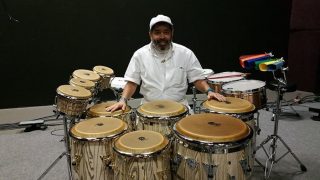
One fact that few musicians know about congas is:
The term “conga” itself, actually refers to only 1 of the 5 common size variations of this instrument.
While there are many name variations for each size, these are the most common names you tend to hear for each head diameter:
- Requinto – 9.75″
- Quinto – 11″
- Conga – 11.75″
- Tumba – 12.5″
- Retumbadora/Super tumba – 14″
The 3 most common sizes for a typical setup are:
- Quinto
- Conga
- Tumba
And the 3 most common size combinations for a setup are:
- Quinto/Conga
- Conga/Tumba
- Quinto/Conga/Tumba
And finally, if you’re playing on only a single drum, the conga size is definitely the way to go, as it offers the most versatile range of tones.
Moving on…
What Are Conga Shells Typically Made From?
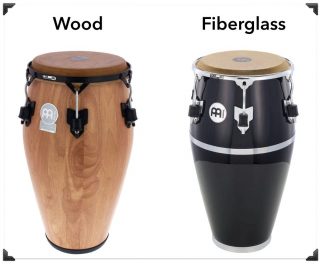
The two most common materials used to build conga shells are:
- Wood – which is heavier, and has a warm, deep sound
- Fiberglass – which is lighter, and has a crisp, louder sound
As a rule of thumb, wooden shells are far more weather-sensitive than fiberglass…
Meaning they are prone to bending and flexing with humidity changes that often occur as a result of travel.
For this reason, combined with their lighter weight, a good argument can be made for why fiberglass congas are more suitable for touring.
On the other hand, there would be no reason to use wood, unless a good majority of conga players still preferred its sound.
Have a look at the videos below to hear and compare the differences between wood and fiberglass shells:
Fiberglass Shell
Wood Shell:
The two most common woods used are:
- Siam Oak
- American Ash
While their difference in sound is negligible, American Ash is generally more durable, as it is harder than Siam Oak.
Up next…
The 3 Main Hardware Components of the Conga
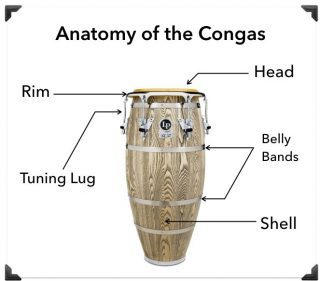
The hardware of a Conga is typically made up of 3 main components:
- The Rim – which holds the drum head on the shell
- The Tuning Lugs – which control the tension of the rim over the head, and are secured through holes in the shell
- Belly Bands – which some congas use to reinforce the shell
These days, due to better shell construction methods, belly bands are mostly unneeded, and exist mainly for aesthetics.
With rims, the two common variations you’ll find are the flat traditional rims, and the modern curved rims. A large majority of today’s players prefer curved rims, as they are much easier on the hands.
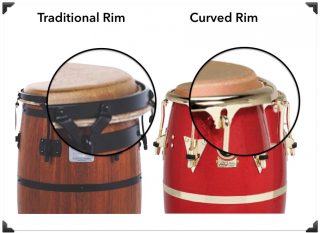
With tuning lugs, you’ll find that common thickness ranges between 7–10 mm. High-end congas usually have thicker lugs, for additional durability.
While the lugs have always been traditionally anchored to holes drilled in the side of the shell…
These days, a new system exists from Meinl called Floatune, which allows the lugs to stay acoustically isolated from the shell, by instead anchoring them from the bottom.
And while the result, at least in theory, should be a superior conga, this design has yet to see mainstream adoption, as it is still rather pricey.
Up next…
Rawhide vs Synthetic Heads: Which is Better?
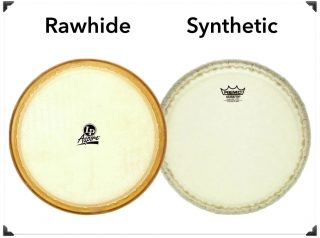
Conga heads materials come in two varieties:
- Rawhide – which produces a warmer deeper sound, but is more weather-sensitive, and requires regular oiling
- Synthetic – which is less weather sensitive, and produces a brighter, crisper sound.
Unlike with most drums these days, which mainly use synthetic heads…
With congas, the vast majority of players still use rawhide. So for all intents and purposes, it’s really the only option worth considering.
Up next…
The Best Conga Models on the Market Today
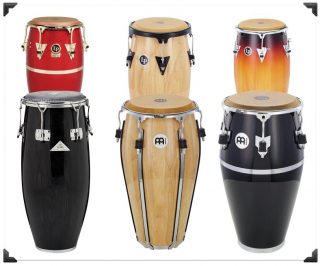
So now that we’ve covered all the most important points of basic conga design…
The only thing left to do is to use your new knowledge to start comparing options.
Currently, the top 2 conga brands on the market are:
- Latin Percussion
- Meinl
Here are my top recommendations from these 2, organized from low to high-end models:
Latin Percussion:
- Aspire
- CitySet
- Galaxy Giovanni Signature
- Galaxy Fiberglass w/Comfort Curve II rims
Meinl:
- Headliner Series
- Classic Series
- Woodcraft Series
- Fibercraft Series (fiberglass shell)
For a few more entry-level options, also check out these models from Toca:
And for more high-end options (oddly enough, with synthetic heads), check out these models from Gon Bops:
- Alex Acuña Series
- California Series (requinto)
Up next…
How to Tune Your New Congas
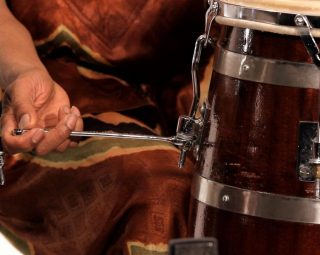
Now that we’ve finished the comparison shopping section of this post…
I’d like to move along to the logical next question that beginners have when their new congas first arrive: How do you tune them?
So…when tuning congas, it doesn’t really matter what order you tighten the lugs (like it does with many other drums).
Instead, the only rule is to give each nut the same amount of turns, so the tension remains even.
While you could tune to the key of the tune, this is rarely done as it would be far too much work to do after each song.
Instead, the common advice is to tune adjacent drums either a perfect 4th, or major 3rd apart.
To see how it’s done, check out this video:
Up next…
How to Maintain Your Congas
With congas, there are two parts that will require some level of regular maintenance.
- The Rawhide Head – which needs an occasional rub-down with almond oil or lanolin when it feels dry
- The Tuning Lugs – which require their own lubrication as well
If you need any of these things, here are some links for you:
By the way, if you found this post useful, I highly recommend joining our free Home Recording Secrets email newsletter where you’ll discover….
- How to Get Your First Studio Up and Running in a Single Weekend
- How to Avoid Wasting Thousands of Dollars on Unnecessary Pointless Purchases
- How to Get a “Million Dollar” Pro Studio Sound in a “Thousand Dollar” Home Studio
- PLUS… All Sorts of Other Amazing Insider Secrets Revealed
And it’s totally FREE! Click here and Enter Your Email to Sign Up.
More Drum/Percussion Posts in this Series:
Drum Sets | Electronic Drums | Snares | Drumheads | Cymbals | Djembe | Bongos | Cajon | Conga | Cowbell | Tambourines | Vibraphones | Xylophones | Marimbas | Glockenspiels | Metronomes | Drum Thrones | Drumsticks | Ride Cymbals